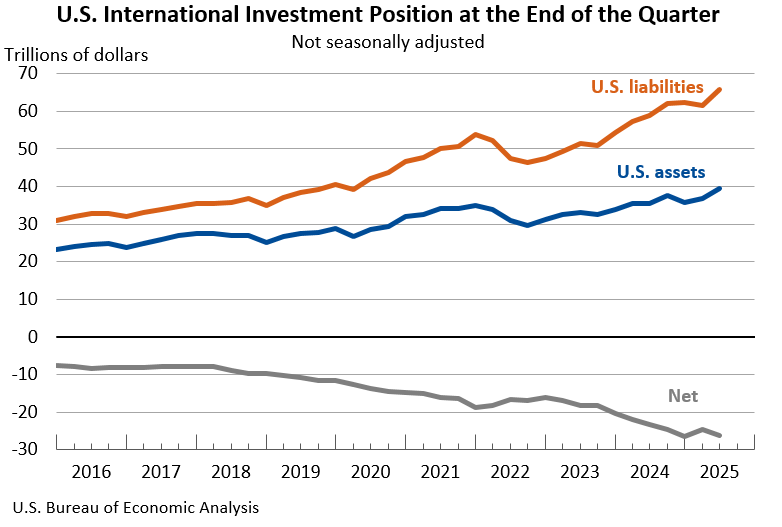Notice
Due to a lapse in appropriations, this website is not being updated.
Bureau of Economic Analysis
U.S. International Investment Position, 2nd Quarter 2025
The U.S. net international investment position, the difference between U.S. residents’ foreign financial assets and liabilities, was -$26.14 trillion at the end of the second quarter of 2025, according to statistics released today by the U.S. Bureau of Economic Analysis. Assets totaled $39.56 trillion, and liabilities were $65.71 trillion. At the end of the first quarter, the net investment position was -$24.65 trillion (revised).
Principal Federal Economic Indicators
Noteworthy
The Latest
Personal Income and Outlays, January 2018
Personal income increased 0.4 percent in January, the same increase as in December. Wages and salaries, the largest component of personal income, increased 0.5 percent in January after increasing 0.4 percent in December.
Disposable Personal Income Rises in January
Personal income increased 0.4 percent in January, the same increase as in December. Wages and salaries, the largest component of personal income, increased 0.5 percent in January after increasing 0.4 percent in December.
GDP Increases in Fourth Quarter
Real gross domestic product (GDP) increased 2.5 percent in the fourth quarter of 2017, according to the "second" estimate released by the Bureau of Economic Analysis. In the third quarter, real GDP increased 3.2 percent.
Gross Domestic Product, 4th quarter and annual 2017 (second estimate)
Real gross domestic product (GDP) increased at an annual rate of 2.5 percent in the fourth quarter of 2017 (table 1), according to the "second" estimate released by the Bureau of Economic Analysis. In the third quarter, real GDP increased 3.2 percent.
Coming Attraction: See How Arts and Culture Impact Every State
The Bureau of Economic Analysis is lifting the curtain on the role arts and culture play in each state's economy.
On March 6, BEA will premiere statistics showing for the first time how much arts and culture contribute to the gross domestic product, or GDP, of all 50 states and the District of Columbia. The arts and cultural economy includes music, theater, design, museums, historic sites, natural parks and more, as well as supporting…
Prototype Statistics: Outdoor Recreation Accounted for 2 Percent of GDP in 2016
Americans who hit the trails to ski, bike or hike aren’t just working up a sweat; they’re also generating economic activity. Outdoor recreation accounted for 2.0 percent of the U.S. economy, or $373.7 billion, in 2016, according to prototype statistics for the Bureau of Economic Analysis’ newest special account.
Outdoor Recreation Satellite Account, Prototype Estimates, 2012-2016
Prototype statistics from the Outdoor Recreation Satellite Account (ORSA) released by the U.S. Department of Commerce's Bureau of Economic Analysis (BEA) show that the outdoor recreation economy accounted for 2.0 percent ($373.7 billion) of current-dollar GDP in 2016 (table 1). In addition, the outdoor recreation economy grew 3.8 percent in 2016, compared to growth of 2.8 percent in the overall economy.
Swim, Sail or Ski to bea.gov for an Outdoor Rec Preview
BEA’s first look at the outdoor recreation economy is coming Feb. 14, but you can get a sneak peek right now at what the statistics will cover.
We’ve posted the blank data tables on the Outdoor Recreation Satellite Account page of bea.gov. Glance over the tables to see how BEA will present its prototype statistics on activities like camping, hunting and boating, as well as related production by industries, such as retail trade,…
2017 Trade Gap is $566.0 Billion
The U.S. international trade deficit increased in 2017 according to the U.S. Bureau of Economic Analysis and the U.S. Census Bureau. The deficit increased from $504.8 billion in 2016 to $566.0 billion in 2017, as imports increased more than exports. As a percentage of U.S. gross domestic product, the goods and services deficit was 2.9 percent in 2017, up from 2.7 percent in 2016. The goods deficit increased from $752.5 billion in 2016 to $810…
U.S. International Trade in Goods and Services, December 2017
The U.S. monthly international trade deficit increased in December 2017 according to the U.S. Bureau of Economic Analysis and the U.S. Census Bureau. The deficit increased from $50.4 billion in November (revised) to $53.1 billion in December, as imports increased more than exports.




